overheating CHEVROLET BLAZER 1994 2.G Owners Manual
[x] Cancel search | Manufacturer: CHEVROLET, Model Year: 1994, Model line: BLAZER, Model: CHEVROLET BLAZER 1994 2.GPages: 348, PDF Size: 17.88 MB
Page 6 of 348
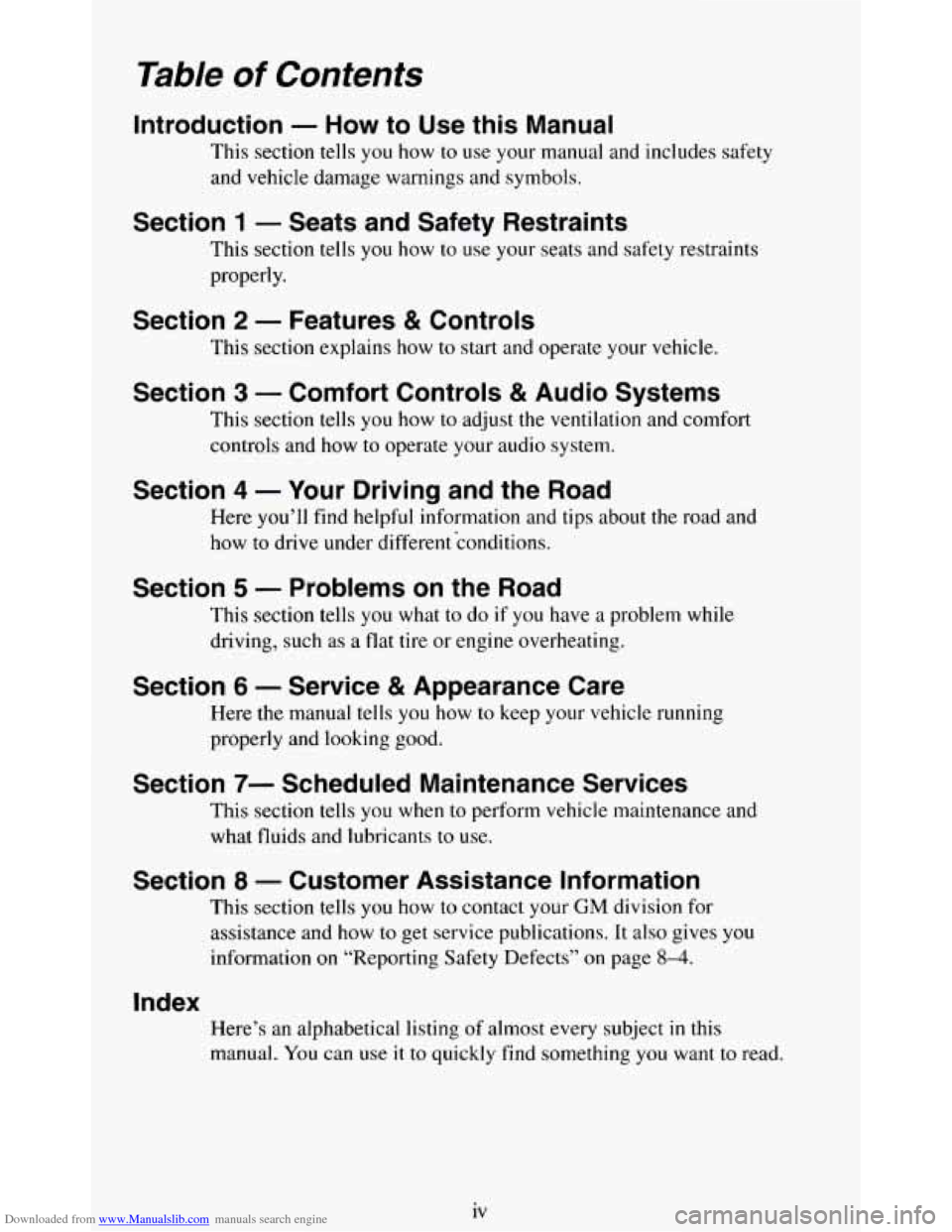
Downloaded from www.Manualslib.com manuals search engine Table of Contents
Introduction - How to Use this Manual
This section tells you how to use your manual and includes safety
and vehicle damage warnings and symbols.
Section 1 - Seats and Safety Restraints
This section tells you how to use your seats and safety restraints
properly.
Section 2 - Features & Controls
This section explains how to start and operate your vehicle.
Section 3 - Comfort Controls & Audio Systems
This section tells you how to adjust the ventilation and comfort
controls and how
to operate your audio system.
Section 4 - Your Driving and the Road
Here you’ll find helpful information and tips about the road and \
how
to drive under different conditions.
Section 5 - Problems on the Road
This section tells you what to do if you have a problem while
driving, such as a flat tire or engine overheating.
Section 6 - Service & Appearance Care
Here the manual tells you how to keep your vehicle running
properly and looking good.
Section 7- Scheduled Maintenance Services
This section tells you when to perform vehicle maintenance and
what fluids and lubricants
to use.
Section 8 - Customer Assistance Information
This section tells you how to contact your GM division for
assistance and how
to get service publications. It also gives you
information
on “Reporting Safety Defects” on page 8-4.
Index
Here’s an alphabetical listing of almost every subject in this
manual. You can use
it to quickly find something you want to read.
1v
Page 124 of 348
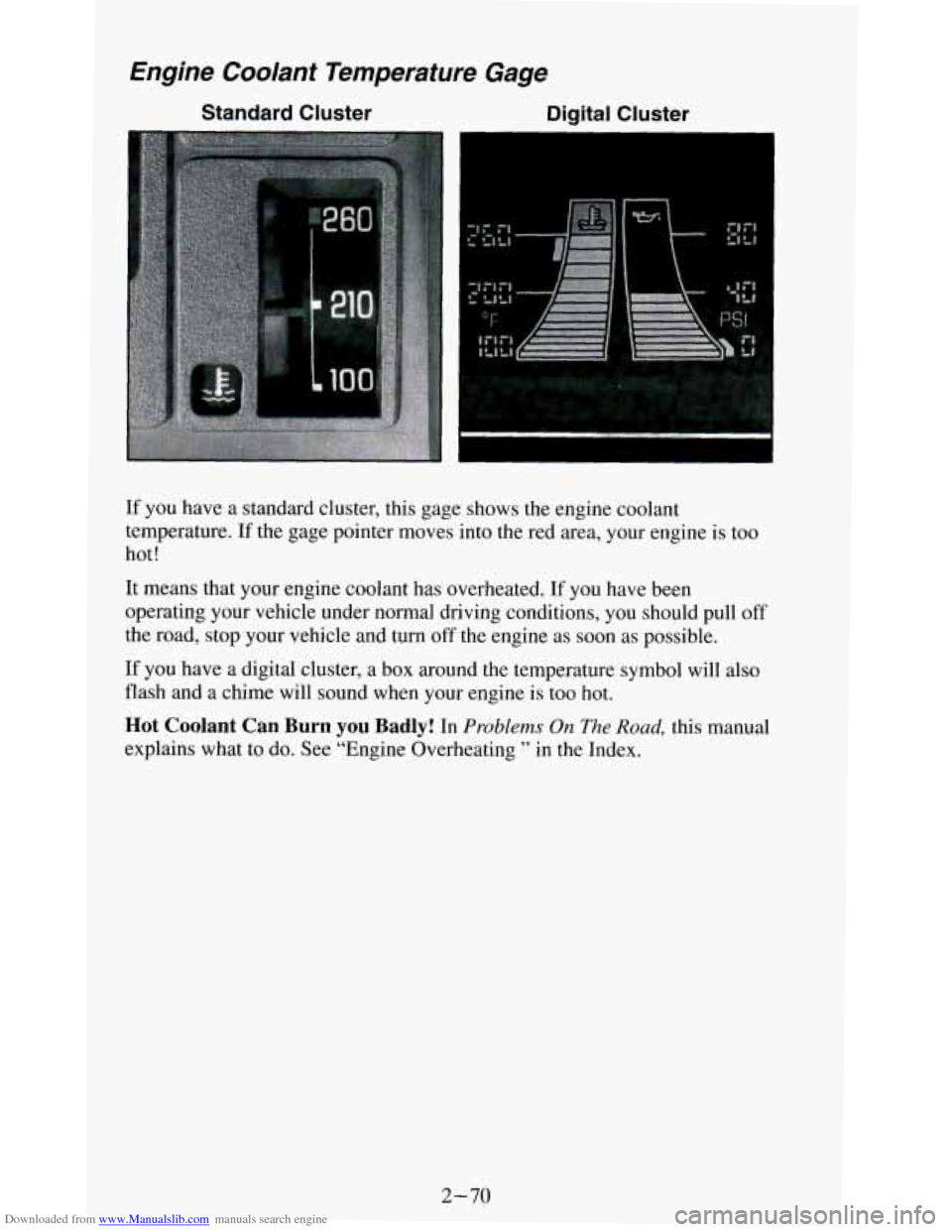
Downloaded from www.Manualslib.com manuals search engine Engine Coolant Temperature Gage
Standard Cluster Digital Cluster
If you have a standard cluster, this gage shows the engine coolant
temperature.
If the gage pointer moves into the red area, your engine is too
hot!
It means that your engine coolant has overheated.
If you have been
operating your vehicle under normal driving conditions, you should pull
off
the road, stop your vehicle and turn off the engine as soon as possible.
If you have a digital cluster, a box around the temperature symbol will also
flash and a chime will sound when your engine is too hot.
Hot Coolant Can Burn you Badly! In Problems On The Road, this manual
explains what to do. See “Engine Overheating
” in the Index.
2-70
Page 200 of 348
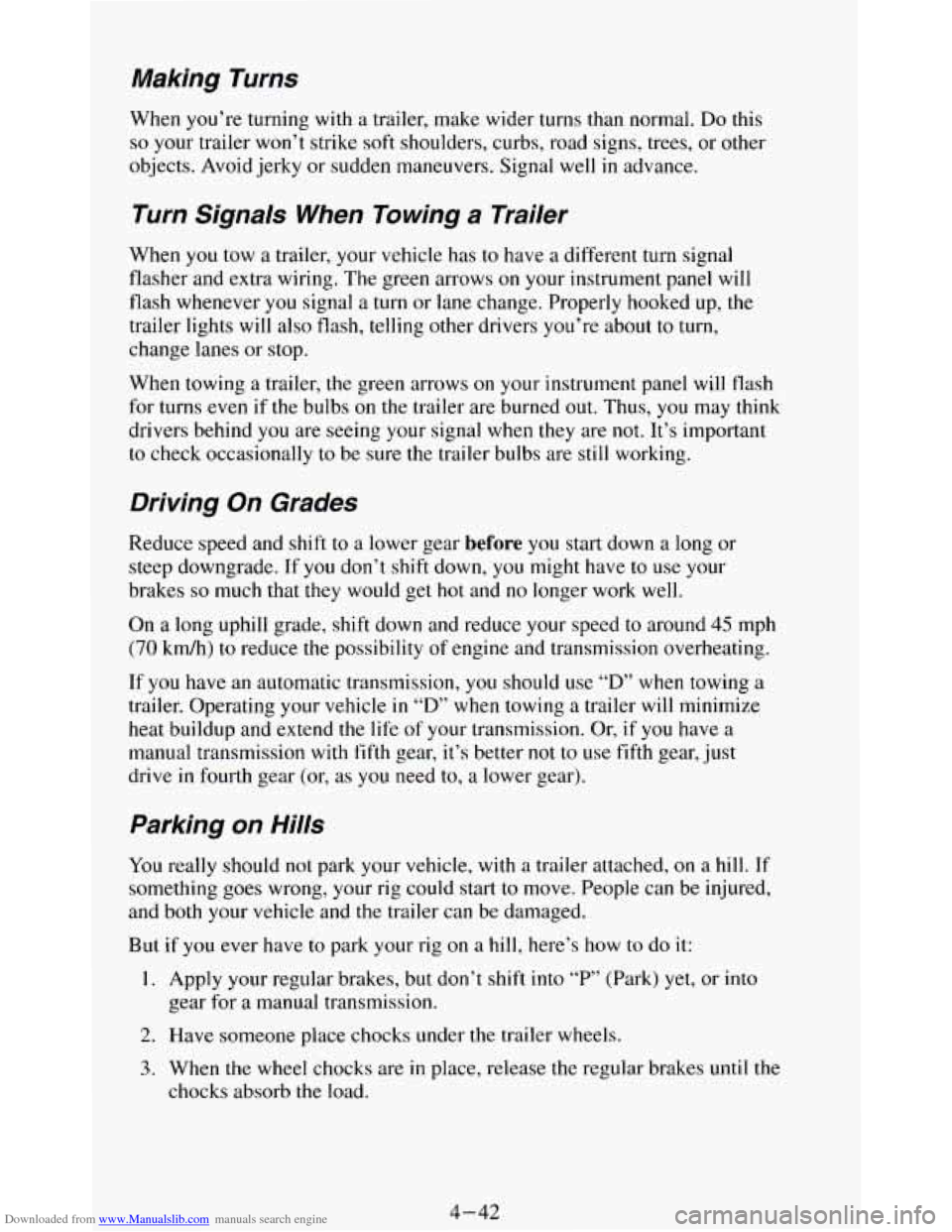
Downloaded from www.Manualslib.com manuals search engine Making Turns
When you’re turning with a trailer, make wider turns than normal. Do this
so your trailer won’t strike soft shoulders, curbs, road signs, trees, or other
objects. Avoid jerky or sudden maneuvers. Signal well
in advance.
Turn Signals When Towing a Trailer
When you tow a trailer, your vehicle has to have a different turn signal
flasher and extra wiring. The green arrows
on your instrument panel will
flash whenever you signal a turn or lane change. Properly hooked up, the
trailer lights will also flash, telling other drivers you’re about to turn,
change lanes or stop.
When towing a trailer, the green arrows
on your instrument panel will flash
for turns
even if the bulbs on the trailer are burned out. Thus, you may think
drivers behind you are seeing your signal when
they are not. It’s important
to check occasionally to be sure the trailer bulbs are still working.
Driving On Grades
Reduce speed and shift to a lower gear before you start down a long or
steep downgrade. If you don’t
shift down, you might have to use your
brakes
so much that they would get hot and no longer work well.
On a long uphill grade, shift down and reduce your speed
to around 45 mph
(70 kdh) to reduce the possibility of engine and transmission overheating.
If you have an automatic transmission,
you should use “D” when towing a
trailer. Operating your vehicle in “D” when towing a trailer will minimize
heat buildup and extend the
life of your transmission. Or, if you have a
manual transmission with
fifth gear, it’s better not to use fifth gear, just
drive in fourth gear (or, as
you need to, a lower gear).
Parking on Hills
You really should not park your vehicle, with a trailer attached, on a hill. If
something goes wrong, your rig could start to move. People can be injured,
and both your vehicle and the trailer can be damaged.
But if you ever have
to park your rig on a hill, here’s how to do it:
1. Apply your regular brakes, but don’t shift into “P” (Park) yet, or into
gear for a manual transmission.
2. Have someone place chocks under the trailer wheels.
3. When the wheel chocks are in place, release the regular brakes until the
chocks absorb
the load.
4-42
Page 203 of 348
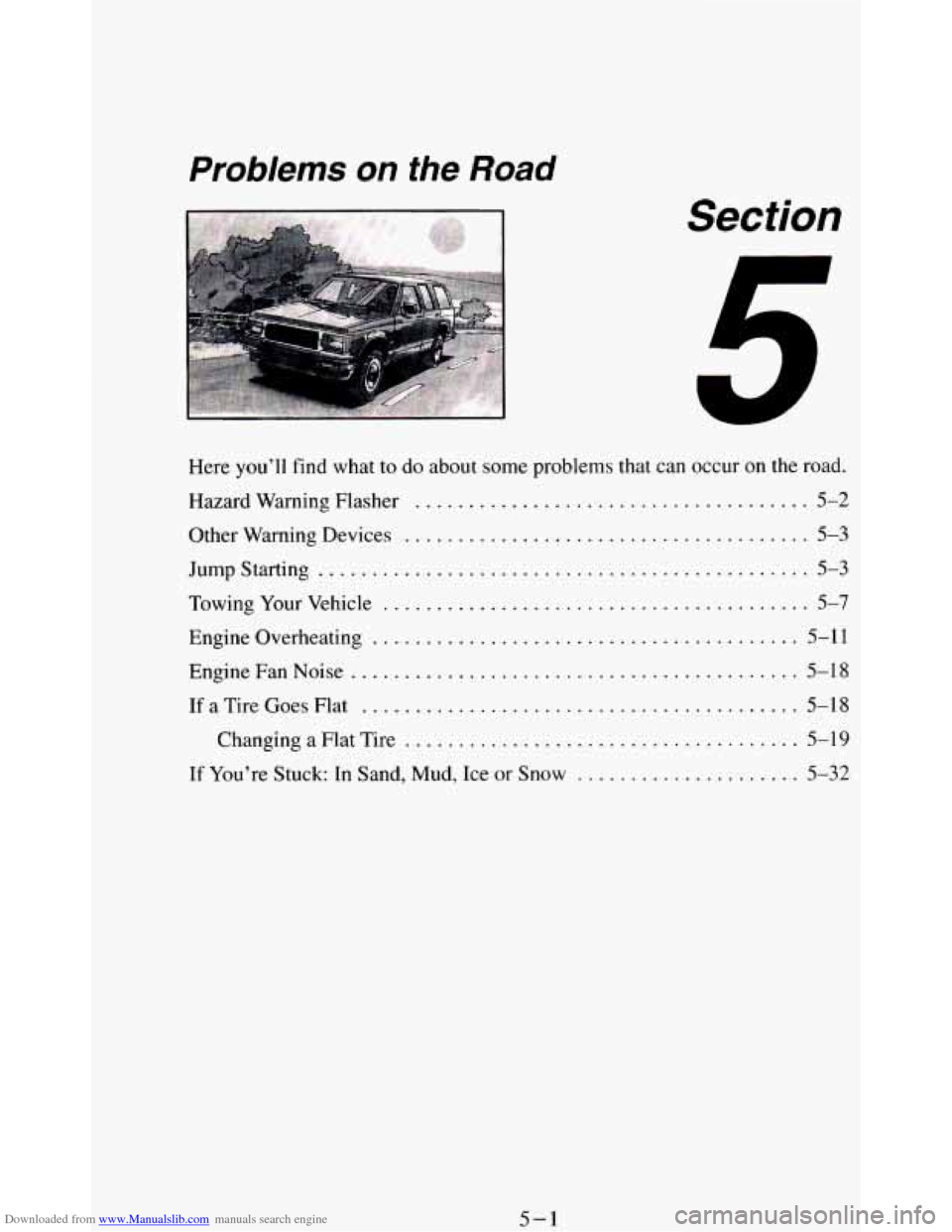
Downloaded from www.Manualslib.com manuals search engine Here you’ll find what to do about some problems
Hazard Warning Flasher
...................
Other Warning Devices ....................
Jump Starting ............................
Towing Your Vehicle ......................
Engine Overheating .......................
Engine Fan Noise .........................
If a Tire Goes Flat ........................
Changing a Flat Tire ....................
If You’re Stuck: In Sand. Mud. Ice or Snow ....
Seciion
that can occur on
..............
..............
..............
..............
..............
..............
the road .
....
5-2
.... 5-3
.... 5-3
.... 5-7
... 5-11
... 5-18
................. 5-18
................. 5-19
................. 5-32
5-1
Page 213 of 348
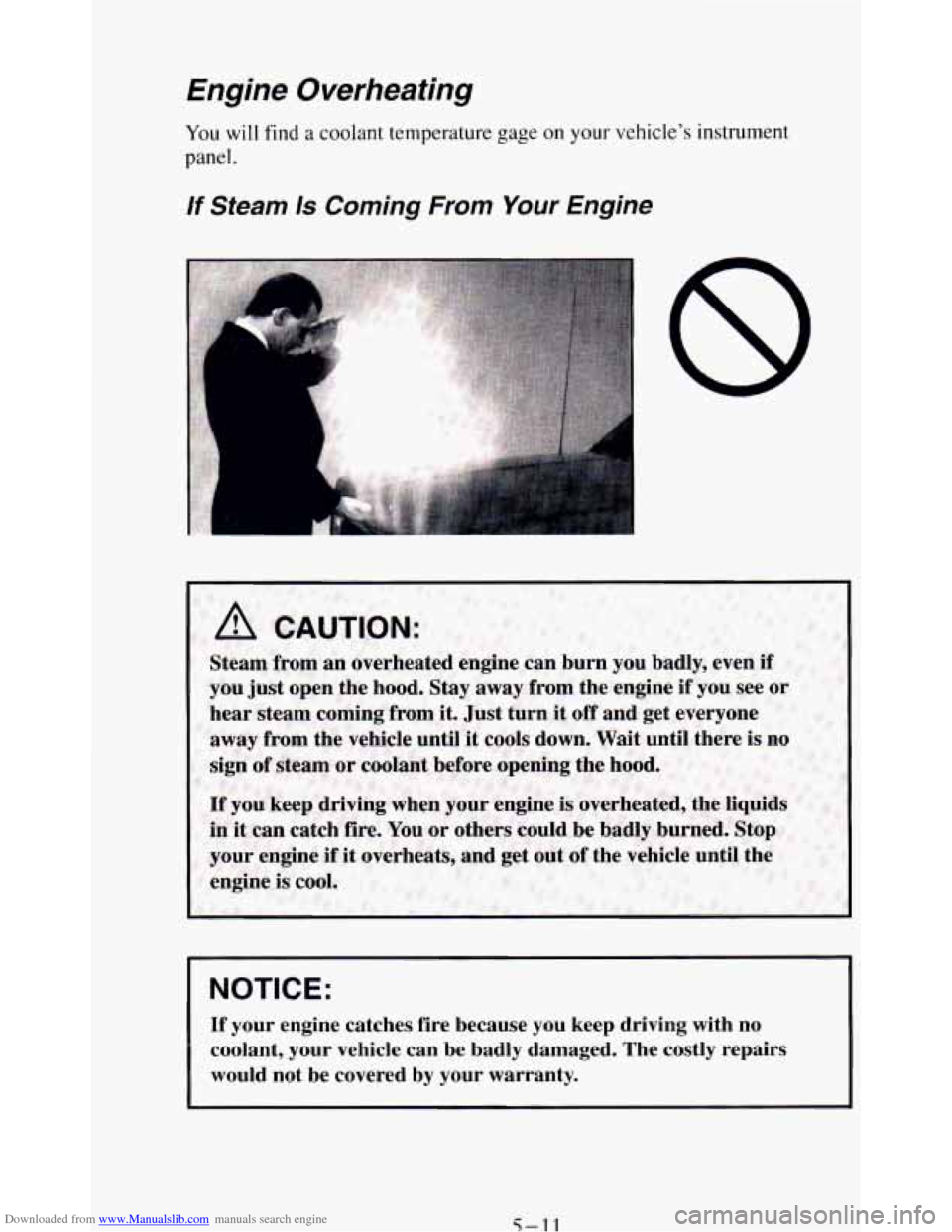
Downloaded from www.Manualslib.com manuals search engine Engine Overheating
You will find a coolant temperature gage on your vehicle's instrument
panel.
lf Steam /s Coming From Your Engine
NOTICE:
If your engine catches fire because you keep driving with no
coolant, your vehicle can be badly damaged. The costly repairs \
would not be covered by your warranty.
5-11
Page 259 of 348
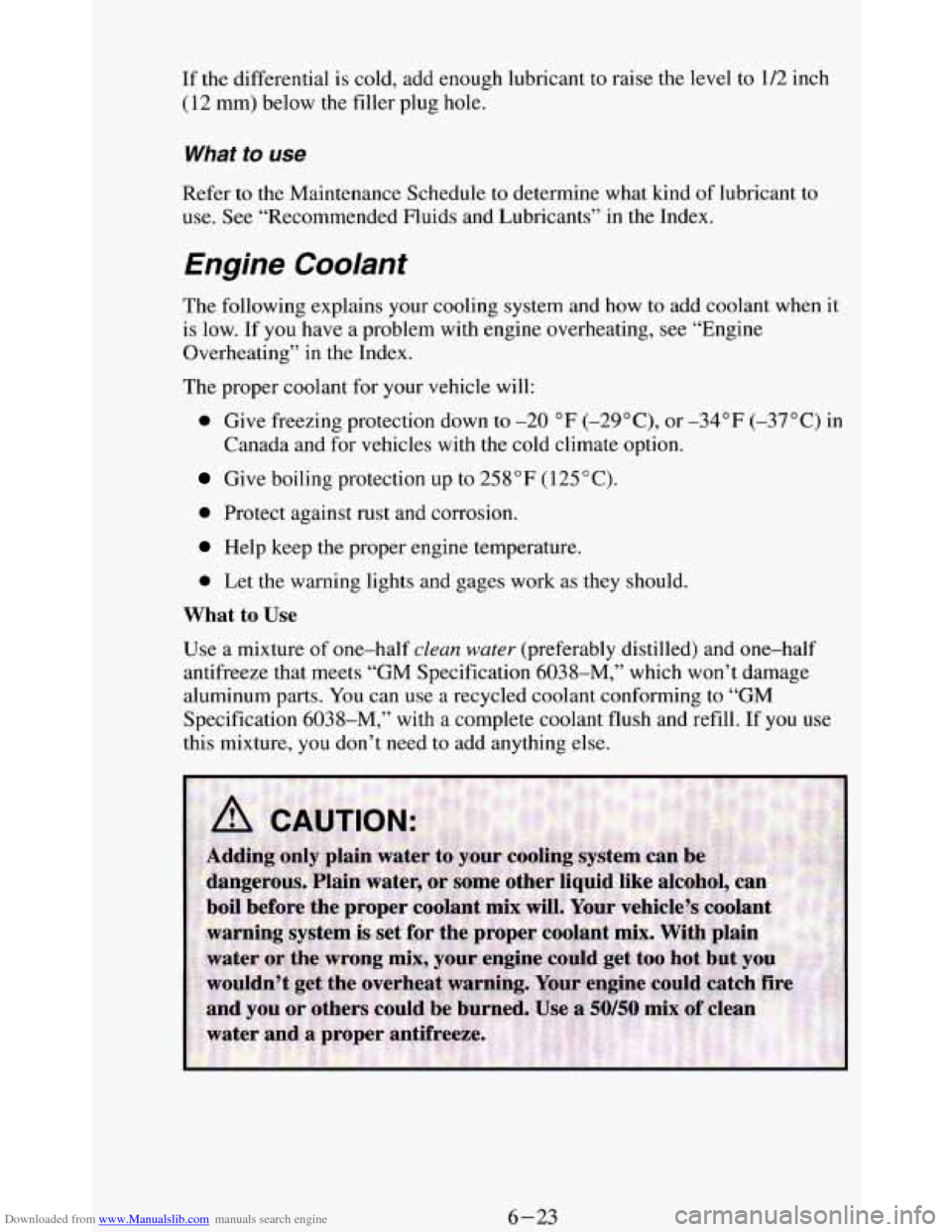
Downloaded from www.Manualslib.com manuals search engine If the differential is cold, add enough lubricant to raise the level to 1/2 inch
(12 mm) below the filler plug hole.
What to use
Refer to the Maintenance Schedule to determine what kind of lubricant to
use.
See “Recommended Fluids and Lubricants” in the Index.
Engine Coolanr
The following explains your cooling system and how to add coolant when it
is
low. If you have a problem with engine overheating, see “Engine
Overheating” in the Index.
The proper coolant for your vehicle will:
0 Give freezing protection down to -20 “F (-29”C), or -34°F (-37°C) in
Give boiling protection up to 258°F (125°C).
Canada
and for
vehicles with the cold climate option.
0 Protect against rust and corrosion.
Help keep the proper engine temperature.
0 Let the warning lights and gages work as they should.
What to Use
Use a mixture of one-half clean water (preferably distilled) and one-half
antifreeze that meets “GM Specification 6038-M,” which won’t damage
aluminum parts.
You can use a recycled coolant conforming to “GM
Specification 6038-M,” with a complete coolant flush and refill. If you use
this mixture, you don’t need to add anything else.
6-23
Page 261 of 348
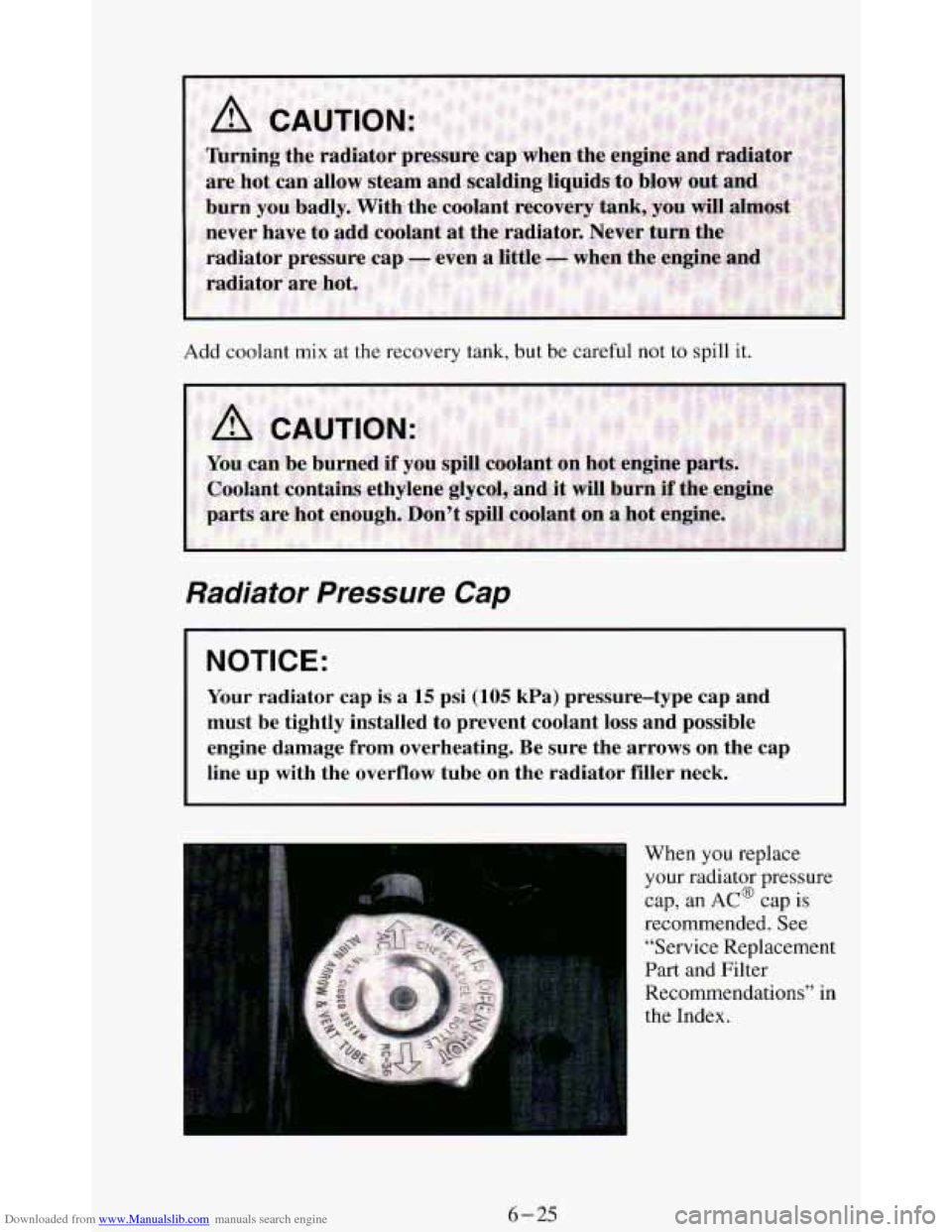
Downloaded from www.Manualslib.com manuals search engine Add coolant mix at the recovery tank, but be careful not to spill it.
Radiator Pressure Cap
NOTICE:
Your radiator cap is a 15 psi (105 kPa) pressure-type cap and
must be tightly installed to prevent coolant
loss and possible
engine damage from overheating.
Be sure the arrows on the cap
line
up with the overflow tube on the radiator filler neck.
When you replace
your radiator pressure
cap, an
AP cap is
recommended. See
“Service Replacement
Part and Filter
Recommendations” in
the Index.
6-25
Page 339 of 348
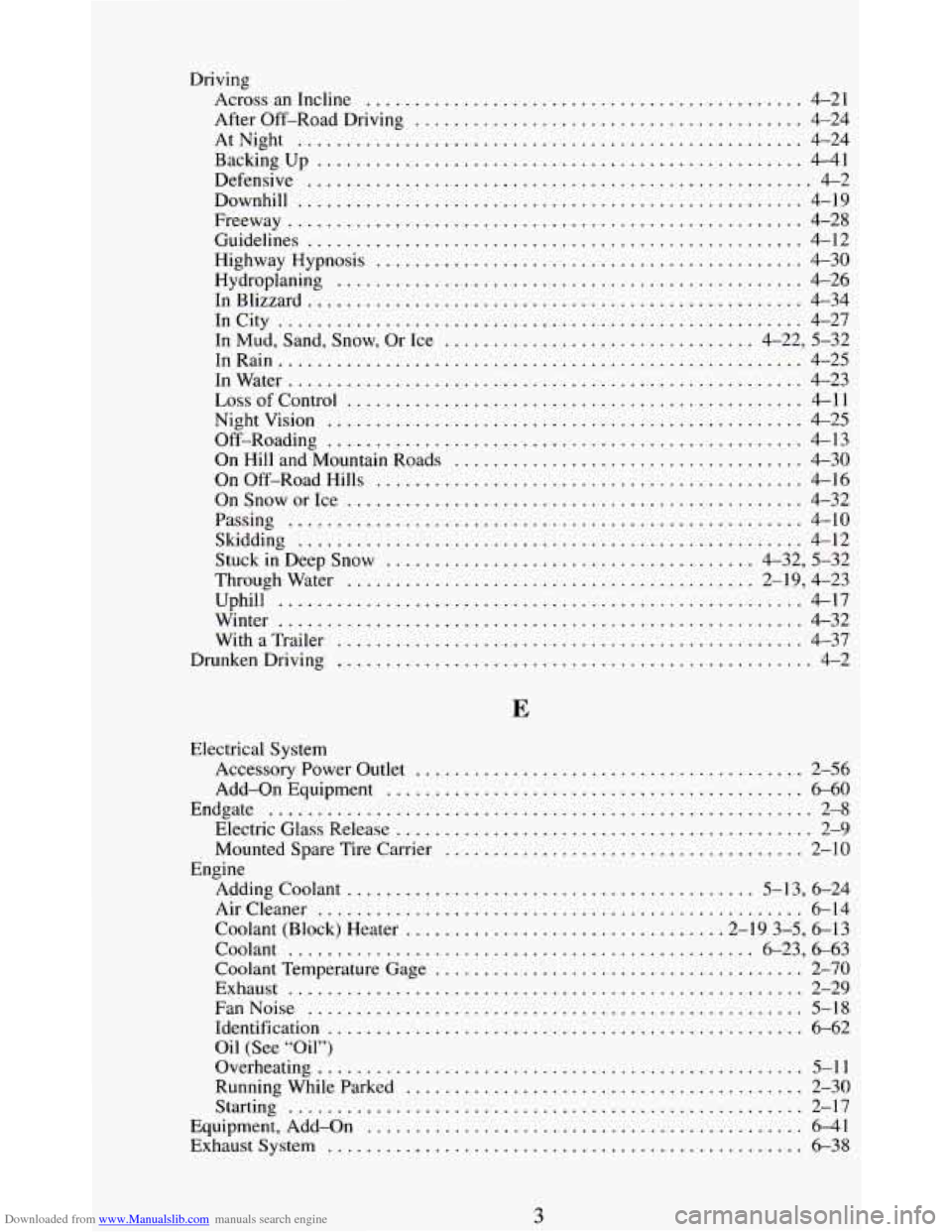
Downloaded from www.Manualslib.com manuals search engine Driving Across an Incline
............................................. 4-21
After Off-Road Driving
........................................ 4-24
AtNight
.................................................... 4-24
BackingUp
.................................................. 4-41
Defensive
.................................................... 4-2
Downhill
.................................................... 4-19
Freeway
..................................................... 4-28
Guidelines
................................................... 4-12
Highway Hypnosis
............................................ 4-30
Hydroplaning
................................................ 4-26
InBlizzard
................................................... 4-34
InCity
...................................................... 4-27
In Mud. Sand. Snow. Or Ice
................................ 4-22. 5-32
InRain
...................................................... 4-25
InWater
..................................................... 4-23
LossofControl
............................................... 4-11
Nightvision
................................................. 4-25
Off-Roading
................................................. 4-13
On Hill and Mountain Roads
.................................... 4-30
On Off-Road Hills
............................................ 4-16
OnSnoworIce
............................................... 4-32
Passing
..................................................... 4-10
Skidding
.................................................... 4-12
Stuck
in Deep Snow ...................................... 4-32. 5-32
Throughwater
.......................................... 2-19. 4-23
Uphill
...................................................... 4-17
Winter
...................................................... 4-32
With
a Trailer ................................................ 4-37
DrunkenDriving
................................................. 4-2
Electrical System Accessory Power Outlet
........................................ 2-56
Add-on Equipment
........................................... 6-60
Endgate ........................................................ 2-8
Electric Glass Release ........................................... 2-9
Mounted Spare Tire Carrier
..................................... 2-10
Adding Coolant
.......................................... 5-1 3. 6-24
Aircleaner
.................................................. 6-14
Coolant (Block) Heater
................................. 2-19 3.5, 6-13
Coolant
................................................ 6-23. 6-63
Coolant Temperature Gage
...................................... 2-70
Exhaust ..................................................... 2-29
FanNoise
................................................... 5-18
Identification
................................................. 6-62
Oil (See “Oil”)
Overheating
.................................................. 5-11
RunningWhileParked
......................................... 2-30
Starting
..................................................... 2-17
Equipment, Add-on ............................................. 6-41
Exhaustsystem ................................................. 6-38
Engine
3